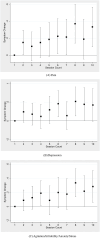Cannabis tolerance reduces symptom relief
- PMID: 40612739
- PMCID: PMC12223318
- DOI: 10.3389/fphar.2025.1496232
Cannabis tolerance reduces symptom relief
Abstract
Objectives: We measure for the first time how tolerance from repeated consumption of medical cannabis affects acute symptom management.
Methods: Using the Releaf App, medical cannabis patients recorded their symptoms, product type, cannabis consumption method, major cannabinoid levels, dosing patterns, and real-time symptom intensity levels prior to and following each cannabis administration session, as well as any side effects from usage. The sample consists of the first ten cannabis self-administration sessions recorded by 16,395 medical cannabis patients between 06/05/2016 and 09/19/22, yielding a sample of 120,691 symptom-specific treatment-level observations, recorded during 42,005 sessions. This study uses fixed effects least-squares regression analyses to analyze the effects of the session count on symptom relief.
Results: On average, people experienced a 0.5% decrease in symptom relief with each subsequent session (p < 0.001). Combustible products offered more therapeutic relief than vaping, eating or drinking; higher doses offered greater relief; and the reduction in symptom relief with subsequent usage was similar whether patients were treating pain, depression, or anxiety. Cannabis products' THC levels were positively associated with symptom relief; however, patients showed no changes in the THC levels of products with subsequent consumption. Patients increased the dose consumed as they completed more sessions. The results are robust to alternative treatment measures, including days since the first session was recorded. Subsample regressions indicate that experienced users drive most of the effects. Analyses assessing side effects show that factors, such as THC and dose, that increased symptom relief also increased side effects experienced.
Conclusion and implications: The findings suggest the majority of patients experience decreased symptom relief after repeated use of medical cannabis, counterbalanced by improvements in negative side effects. Of direct clinical relevance, THC levels and the dose can be adjusted to customize medical cannabis patient treatment, increase medication compliance, and improve treatment outcomes.
Keywords: addiction; cannabidiol; cannabis; cannabis chemovars; complementary medicine; marijuana; tetrahydrocannabinol; tolerance.
Copyright © 2025 Stith, Li, Brockelman, Keeling, Hall and Vigil.
Conflict of interest statement
FB was employed by MoreBetter, Ltd. KK and BH are employed by MoreBetter, Ltd. JV owns a licensed New Mexico cannabis retailer and manufacturer (Dr. V's Mountain Meds LLC.). SS is married to JV. The remaining author declares that the research was conducted in the absence of any commercial or financial relationships that could be construed as a potential conflict of interest.
Figures



References
LinkOut - more resources
Full Text Sources

